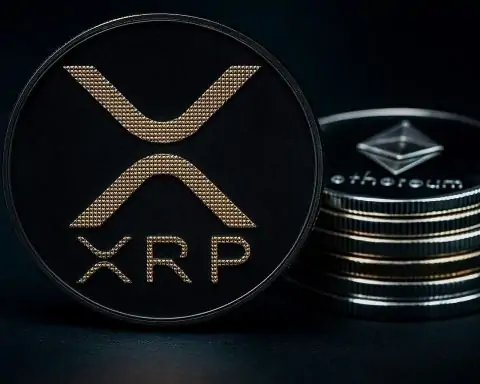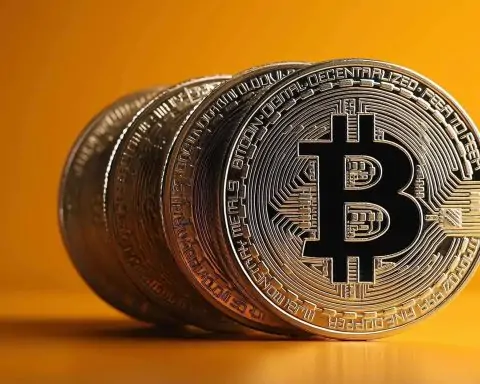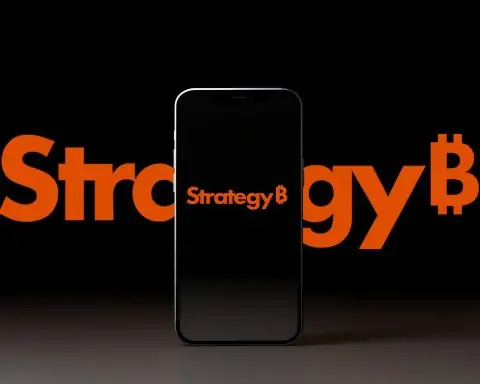Date: November 22, 2025
Category: Blockchain & Crypto Market News
As the crypto market battles one of its toughest months in years, today’s blockchain news is dominated by a historic payments infrastructure upgrade, violent Bitcoin swings, a fresh DeFi front-end hack, and big strategic moves from Coinbase, Binance, and KuCoin.
Below is a detailed, SEO-friendly roundup of the most important blockchain and crypto stories published today, November 22, 2025.
Key Takeaways: Blockchain & Crypto News Today
- SWIFT’s ISO 20022 cutover goes live today, shifting global bank-to-bank payments onto richer data rails that are friendlier to tokenization and blockchain connectivity. [1]
- Bitcoin is stabilizing around $83K–$84K after a brutal November sell-off, with spot ETFs swinging from record outflows toward early signs of renewed inflows and record trading volumes. [2]
- Bitcoin mining economics worsen sharply as hashprice hits a new all‑time low below $35 per PH/s, squeezing miners after price drops and record difficulty. [3]
- Base-based DEX Aerodrome suffers a front‑end/DNS compromise, reminding users that even when smart contracts are safe, web interfaces can be the weakest link. [4]
- Coinbase and Binance roll out aggressive new strategies—from Solana-native acquisitions and 24/7 altcoin futures to Japanese PayPay integration and new token launches—amid heightened volatility and regulatory scrutiny. TechStock²+2TechStock²+2
- Regulators and bank overseers shift stance on crypto, with the U.S. OCC clarifying that banks can hold crypto to pay blockchain “gas fees” and the Basel Committee chief calling for updated capital rules as stablecoins grow. [5]
- Altcoins and NFTs remain deeply depressed, but XRP, TRON and other majors are seeing mixed signals—ranging from ETF-driven optimism to technical “buy” indicators. [6]
- Global crypto events are in full swing today, with large conferences in Dubai and Thessaloniki focused on DeFi, Web3, tokenization and regulation. [7]
1. SWIFT’s ISO 20022 Cutover Goes Live — A New Rail for Tokenized Finance
Today marks a once‑in‑a‑generation infrastructure change in global payments.
SWIFT has formally ended its CBPR+ “coexistence” period and moved all cross‑border bank‑to‑bank payment messages onto the ISO 20022 data standard, effective 22 November 2025. [8]
ISO 20022 doesn’t “bless” any particular cryptocurrency. Instead, it standardizes how financial data is structured and exchanged—enabling richer, machine‑readable messages that make compliance, analytics, and interoperability easier. Analyses from CCN and others stress that while networks like Ripple’s XRP Ledger and Stellar are technically aligned with ISO 20022, the upgrade is about messaging, not about any token being “officially approved.” [9]
Crypto‑focused coverage from exchanges such as MEXC highlights why today matters for blockchain: the global payments network’s switch to ISO 20022 is expected to make it easier to handle tokenized assets, CBDCs, and stablecoins on top of existing rails, by allowing more granular data on things like asset type, origin of funds, and compliance metadata. [10]
Why it matters for blockchain
- Tokenization-friendly messaging: Richer data fields in ISO 20022 can carry details about tokenized securities, on‑chain transaction IDs, and reference data, making it easier to plug regulated digital assets into legacy payment flows.
- Regulators get better visibility: More structured data supports advanced AML/CTF monitoring, potentially lowering some institutional objections to using public blockchains as settlement layers.
- Narrative boost for “ISO‑aligned” projects: While ISO 20022 doesn’t automatically choose winners, today’s cutover is already being used in marketing narratives for XRP, XLM and tokenization platforms looking to position themselves at the center of next‑gen cross‑border settlements. [11]
For now, the upgrade is mostly back‑end plumbing, but it sets the stage for deeper integration of blockchain rails with $150+ trillion in annual SWIFT flows over the coming years. [12]
2. Bitcoin Price Today: Stabilizing Around $84K After a Brutal November
On the market side, Bitcoin (BTC) continues to digest one of its worst monthly pullbacks in recent memory.
- CoinCentral reports that BTC has fallen more than 33% from its all‑time high around $126,000, trading close to $84,000 as of today. [13]
- The MinerMag similarly notes BTC around $83,000, with the decline wiping out year‑to‑date gains. [14]
- A TS2.Tech market update describes Bitcoin as “stabilizing near $84K after a brutal November sell‑off.” TechStock²
Several outlets underline that this drop is not just a crypto story anymore. Morningstar/MarketWatch, for example, frames Bitcoin’s plunge from an October record high as an increasingly important barometer for broader risk sentiment in equities and other asset classes. [15]
Other daily digests (including Meyka and Crypto Valley Journal) emphasize that BTC’s intraday lows below $82,000–$90,000 have come alongside multi‑year lows for many altcoins, intensified by a U.S. government shutdown that has disrupted normal price discovery across markets. [16]
3. ETF Whiplash: Record Outflows, Record Volumes, and Early Signs of a Turn
Behind the price action is a violent tug‑of‑war in Bitcoin ETFs:
- CoinCentral reports nearly $1 billion in outflows from Bitcoin ETFs over recent days, with BlackRock’s IBIT alone losing about $355 million, contributing to what may be the worst weekly outflow since February. The outlet cites research suggesting each $1 billion of ETF outflows can translate into roughly a 3.4% drop in BTC price. [17]
- A Bitget market note estimates total November Bitcoin ETF outflows near $3 billion, with about $2.1 billion of that coming from BlackRock’s flagship fund. [18]
- A separate analysis of U.S. spot ETFs pegs cumulative November outflows even higher, at roughly $3.79 billion across 11 funds, underscoring how aggressively some institutions have been taking profits or de‑risking. [19]
Paradoxically, that selling coincides with record trading activity. BeInCrypto reports that spot Bitcoin ETFs logged their busiest session ever, with $11.5 billion in volume, and BlackRock’s IBIT accounting for more than $8 billion of that turnover. Most ETF holders are now sitting on unrealized losses after buying near the top, which can accelerate volatility as sentiment changes. [20]
There are, however, some green shoots:
- 99Bitcoins notes that ETF desks finally flipped back to net inflows today, with BTC/USD pushing back toward the $85,000 area as traders bet on a >70% probability of a Federal Reserve rate cut, rekindling risk appetite. [21]
- An AInvest “Ethereum News Today” brief highlights how $300 million in leveraged positions were wiped out in a single hour on November 21—and around $2.2 billion in leveraged bets over 24 hours—which may have forced weak hands out of the market and reduced some of the most fragile leverage. [22]
Macro‑focused coverage from major financial outlets, plus a widely cited JPMorgan analysis referenced by Forbes, warn that this drawdown could evolve into a deeper crypto bear phase into 2026 if liquidity dries up further and risk sentiment sours again. [23]
4. Bitcoin Mining Under Pressure: Hashprice Hits a Record Low
Another major story today is the strain on Bitcoin miners.
The MinerMag reports that Bitcoin’s hashprice—a key measure of miner revenue per unit of hashpower—has fallen to a new all‑time low below $35 per petahash per second (PH/s). This is driven by the combination of a sharply lower BTC price and near‑record network difficulty, which together mean miners earn less for the same amount of computing power. [24]
Key points from the mining side:
- BTC’s drop of 30%+ from last month’s all‑time high has erased much of the profitability miners briefly enjoyed during the bull phase. [25]
- Difficulty and hashrate set record levels earlier this month, so the network is still highly secure—but that security now comes at a much steeper cost to miners’ balance sheets. [26]
If prices stay around the low‑$80Ks for long, the market may see smaller or higher‑cost miners capitulate, potentially leading to short‑term hashrate pullbacks but better conditions for remaining operators.
5. DeFi Security: Aerodrome’s Front-End Breach on Base
Security remains a central theme in blockchain news today.
On Base, Coinbase’s Layer‑2 network, Aerodrome, one of the chain’s top DEXs, reported a suspected front‑end compromise. In a public statement amplified by aggregators like CryptoRank, Aerodrome warned users:
It is investigating a front-end compromise and asking users not to access the site via any URL—primary domain or decentralized mirrors—until the team confirms things are safe. At the time of writing, smart contracts appear secure. [27]
Further coverage points toward DNS hijacking and malicious signature prompts, a pattern seen in several other DeFi incidents this year. XT.com, citing data from a Global Ledger report, notes that over $3 billion was stolen in early 2025 across various hacks, with attackers often laundering funds within minutes—sometimes before teams even realize a breach has occurred. [28]
Takeaway for users and builders:
- Even when on‑chain contracts are safe, compromised front‑ends can trick users into signing harmful transactions.
- Multi‑factor domain security, signed front‑end bundles, and education around checking transaction details in wallets are becoming just as important as formal contract audits.
6. Coinbase Today: Solana Push, 24/7 Altcoin Futures, and ETH-Backed Loans
A detailed TS2.Tech roundup of Coinbase news for November 22, 2025 highlights a multi‑pronged strategy aimed at on‑chain liquidity, derivatives, and credit. TechStock²
6.1 Vector.fun Acquisition: Deepening Solana Liquidity
Coinbase confirmed plans to acquire Vector.fun, a Solana‑native on‑chain trading app, in what TS2 describes as the exchange’s ninth acquisition of 2025. The deal is expected to close by year‑end and will see Vector integrated directly into Coinbase’s DEX trading experience. TechStock²
Coverage notes that:
- The acquisition strengthens Coinbase’s Solana footprint at a time when Solana DEX volume has exploded past $1 trillion in 2025. TechStock²
- Vector’s order‑routing and discovery tools should give Coinbase users faster access to new Solana tokens, including fast‑moving meme coins and early‑stage launches. TechStock²
6.2 24/7 Altcoin Futures and “Perp‑Style” Contracts
Coinbase Derivatives is also preparing a December derivatives wave:
- From December 5, it will offer 24/7 monthly futures on a basket of altcoins including SHIB, AVAX, BCH, ADA, LINK, DOGE, HBAR, LTC, DOT, XLM, and SUI. TechStock²
- From December 12, Coinbase plans to roll out U.S.‑regulated “perpetual‑style” futures on the same assets—contracts with five‑year expirations that mimic perps while staying within CFTC rules. TechStock²
- Leverage can go up to 10×, with the products targeted at both active retail traders and institutions. TechStock²
Analysts quoted in the piece argue that this expansion deepens liquidity and narrows spreads in major altcoins, while giving U.S. traders an alternative to offshore and decentralized derivatives platforms. TechStock²
6.3 ETH-Backed Loans up to $1 Million
Coinbase has also extended its collateralized loan program to Ethereum:
- Eligible U.S. users can now borrow up to $1 million in USDC against their ETH without selling it, expanding a program previously limited to Bitcoin. TechStock²
The article stresses that these loans essentially function as leveraged positions—helpful for liquidity but risky if ETH falls further, since borrowers can be liquidated.
7. Binance Today: BNB Slide, DIGI Launch, PayPay Integration, and Ongoing Scrutiny
Another TS2.Tech deep dive focuses on Binance’s situation on November 22, 2025, painting a picture of a platform that is simultaneously innovating and under intense scrutiny. TechStock²
7.1 BNB Under Pressure, Alpha Launches DIGI
In today’s trading:
- BNB has underperformed, sliding into the low‑$800s with double‑digit weekly losses even as BTC churns around the low‑$80Ks. TechStock²
- Binance is relying on Alpha‑style token launches and airdrops, including the new DIGI token, to keep users engaged and compensate for “extreme fear” conditions in the broader market. TechStock²
7.2 Japan’s PayPay Integration: A New Fiat Bridge
One of the most concrete product announcements is in Japan:
- Binance Japan users can now buy crypto directly using PayPay Money, withdraw proceeds back into their PayPay balance, and start with as little as JPY 1,000, 24/7 outside maintenance windows. TechStock²
- Customers can also combine PayPay Points and PayPay Money for funding, if they enable the right settings in the PayPay app. TechStock²
The integration effectively turns PayPay’s popular digital wallet into a near‑instant fiat on‑ramp and off‑ramp for Binance Japan—significant in a heavily regulated, historically cash‑heavy market.
7.3 Education, Governance, and New Investigations
TS2’s piece also pulls in several wider narratives: TechStock²
- In Thailand, Binance is pushing a “Money Freedom” campaign, trying to frame crypto as one tool in a broader approach to financial literacy rather than a get‑rich‑quick scheme.
- At a media roundtable in Sydney, CEO Richard Teng argued that Bitcoin’s roughly 21% monthly drop is part of a broader risk‑off move, describing the current phase as “healthy consolidation” after an 18‑month rally.
- At the same time, ICIJ investigations allege that Binance continued to process hundreds of millions of dollars in flows tied to high‑risk counterparties after its 2023 plea deal—claims the exchange disputes while emphasizing its cooperation with law enforcement and its technical limits on blocking deposits.
For traders, the message is clear: Binance remains a central liquidity hub but also a lightning rod for regulatory and reputational risk.
8. KuCoin in Australia: “One Ecosystem With Two Origins”
In Australia, KuCoin is using the Australian Crypto Convention (ACC 2025) to emphasize its push into regulated, localized operations.
A KuCoin press release via PR Newswire details a fireside chat featuring CEO BC Wong and Australian Managing Director James Pinch, under the banner “Regulated, Connected, Converging: The Future of Digital and Traditional Finance.” [29]
Key themes:
- Regulation as stabilizer, not brake: Wong describes security and compliance as structural investments, not reactive measures, referencing KuCoin’s $2 billion Trust Project and newly opened Sydney CBD office. [30]
- Localization: KuCoin stresses “being local”—hiring Australian talent, tailoring products to domestic rules, and supporting the local economy.
- TradFi convergence: Wong characterizes digital and traditional finance as “one ecosystem with two origins—now converging,” highlighting a future where assets, payments, and trading are increasingly digital but still tightly supervised. [31]
For blockchain observers, this underscores how major exchanges are repositioning themselves as regulated infrastructure providers, not just trading venues.
9. Regulation & Banking: Gas Fees, Capital Rules, and Systemic Links
Regulatory and banking news today adds important context to blockchain’s institutional trajectory.
9.1 OCC: Banks Can Pay “Gas Fees” and Hold Operational Crypto
The Bank Policy Institute’s BPInsights newsletter notes that the U.S. Office of the Comptroller of the Currency (OCC) has issued an interpretive letter clarifying that: [32]
- National banks may pay network fees (“gas fees”) on public blockchains to facilitate activities that are otherwise permissible—such as settling tokenized assets or using blockchain as a record‑keeping layer.
- Banks may hold crypto assets as principal on their balance sheets, but only to the extent necessary to pay those fees or test permitted crypto‑related platforms, not for speculative trading.
This effectively gives banks more explicit permission to treat blockchain as a technical rail rather than purely a speculative asset class.
9.2 Basel Committee: Rethinking Crypto Capital Rules
The same BPInsights edition highlights comments from Erik Thedéen, head of the Basel Committee on Banking Supervision, who has called for a revamp of Basel crypto capital rules. [33]
- Current rules, which force banks to hold very high capital against crypto exposures, have faced pushback in the U.S. and UK.
- Thedéen points to the “very strong increase in stablecoins” and the amount of assets in that system as reasons to develop a more nuanced approach, especially as tokenized deposits and on‑chain treasuries spread. [34]
Separately, Reuters reiterates that crypto’s share of traditional finance remains modest but growing, noting that four of 173 U.S. IPOs in 2025 were crypto companies, raising around $1.2 billion (3.3% of total IPO proceeds). [35]
Together, these developments suggest gradual integration rather than outright exclusion of crypto from the regulated banking system.
10. Altcoins, NFTs and XRP: Deep Drawdowns, Tentative Green Shoots
While Bitcoin grabs headlines, alternative crypto assets are quietly enduring some of their worst conditions in years.
A detailed market piece from OneSafe describes how: [36]
- Meme coins have lost roughly $5 billion in value.
- NFT markets are down about 43%, pointing to liquidity contraction and broad de‑risking.
- Even major alt coins like Shiba Inu and Dogecoin have logged severe losses, prompting exchanges to adjust order books to match lower demand.
XRP: Painful Drop, but Bullish Signals
Despite launching multiple XRP ETFs in the U.S.—typically a bullish driver—Ripple’s XRP has not been spared:
- CryptoPotato notes that XRP is down over 15% this week, trading around $1.95 after briefly dipping under $1.90, and is nearly 50% below its July all‑time high. [37]
- At the same time, technical analyst Ali Martinez reports that the TD Sequential indicator has flashed a buy signal; previous such signals preceded double‑digit rebounds of roughly 14% and 18%. [38]
- The article also highlights the planned conversion of Grayscale’s XRP Trust into a spot ETF, which would become the third XRP ETF in the U.S. if it goes ahead—fueling longer‑term optimism even as the market “sells the news” in the short run. [39]
TRON and Others
TRON‑focused coverage from CoinPaper frames TRX as rebounding from key support while the network cements its dominance in stablecoin settlements, underlining how some alt ecosystems are trying to lean on real‑world usage metrics rather than pure speculation. [40]
11. Conferences & Community: Dubai, Thessaloniki and a Packed November
Despite market turmoil, in‑person blockchain events remain vibrant, and today is a particularly active date on the calendar:
- In Dubai, Crypto Horizons 2025 is taking place at Radisson RED Dubai Silicon Oasis. The conference focuses on NFTs, DeFi, the metaverse economy, and blockchain in supply chains, with workshops on crypto payments and regulatory insight sessions. [41]
- In Greece, the Thessaloniki Blockchain Summit 2025 is bringing together developers, investors, and founders to discuss Web3, tokenization, and evolving blockchain regulations, with networking lounges and startup pitch sessions. [42]
- A Pintu News roundup, updated today, describes November 2025 as one of the busiest months ever for crypto events, highlighting Mining Disrupt Texas, Cardano Summit Berlin, Bitcoin Amsterdam, Sub0 Polkadot, Staking Summit Lisbon, the upcoming Ethereum Cypherpunk Congress, and Solana Breakpoint regional sessions. [43]
These gatherings reinforce that while prices are falling, developer and community activity remains strong, setting up the narratives and roadmaps that will likely define 2026.
12. How Today’s Headlines Fit Together
Putting today’s blockchain news into one picture:
- Infrastructure is maturing: SWIFT’s ISO 20022 cutover, OCC guidance on gas fees, and Basel’s reconsideration of crypto capital rules all point toward gradual institutionalization of blockchain as a core financial rail—not just a speculative playground. [44]
- Markets are resetting: Bitcoin’s drop, record ETF outflows, and miner stress suggest a post‑euphoria reset, even as some inflows re‑emerge and volatility invites active traders back in. [45]
- Risk management is front and center: The Aerodrome breach and ongoing investigations into exchange practices show that operational, counterparty, and regulatory risks are just as important as price charts. [46]
- Ecosystems are still building: Exchanges like Coinbase and Binance, and communities gathering at major summits, are investing heavily in infrastructure, derivatives, education, and tokenization—laying groundwork that could matter more than short‑term price swings. Coinpedia Events+4TechStock²+4TechStock²+4
As always, none of this is financial advice. Crypto assets remain highly volatile and speculative. Anyone considering investing should do their own research, understand the risks, and never risk money they cannot afford to lose.
References
1. www.swift.com, 2. coincentral.com, 3. theminermag.com, 4. cryptorank.io, 5. bpi.com, 6. www.onesafe.io, 7. events.coinpedia.org, 8. www.swift.com, 9. www.ccn.com, 10. www.mexc.com, 11. medium.com, 12. genfinity.io, 13. coincentral.com, 14. theminermag.com, 15. www.morningstar.com, 16. meyka.com, 17. coincentral.com, 18. www.bitget.com, 19. finance.yahoo.com, 20. beincrypto.com, 21. 99bitcoins.com, 22. www.ainvest.com, 23. www.forbes.com, 24. theminermag.com, 25. theminermag.com, 26. theminermag.com, 27. cryptorank.io, 28. www.xt.com, 29. www.prnewswire.com, 30. www.prnewswire.com, 31. www.prnewswire.com, 32. bpi.com, 33. bpi.com, 34. bpi.com, 35. www.reuters.com, 36. www.onesafe.io, 37. cryptopotato.com, 38. cryptopotato.com, 39. cryptopotato.com, 40. coinpaper.com, 41. events.coinpedia.org, 42. events.coinpedia.org, 43. pintu.co.id, 44. www.swift.com, 45. coincentral.com, 46. cryptorank.io










